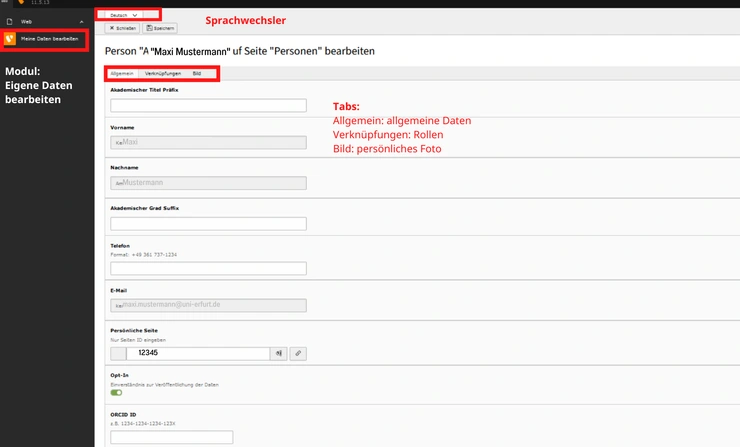The basis of all personal data on the website is the personal database integrated into the backend (TYPO3) - not to be mistaken with the university's general database, which is used, for example, to control the logins for the university's applications. On the university website, we therefore distinguish between the data source - the personal database - and the various applications/presentations of the personal data, such as business cards, which are always created by the web editors - not by the web team.
Thanks to this splitting, all persons with a university login have access to their own data in the website personal database and can update or add data quickly and easily, even without additional TYPO3 training.
How does a person's data get into the personal database?
There is no automatic mechanism for creating new persons and their functions. This means that at the beginning it always needs a message to the web team (via ticket system or email to typo3@uni-erfurt.de) to create the record.
Required are at least:
and
- a function (=role), which must be located at an organisational unit (e.g. faculty, institution or seminar).
In addition, the data can be enriched with further information - in the case of personal data, for example, also a title (prefix or suffix), the ORCID ID, the link to a personal website and a photo.
For each role there are also optional fields:
- email address
- Telephone
- Fax
- Room
- Postal address
- Visiting address
- Office hours (with optional link)
Each personal data record is immediately translated into English by the web team when it is created.
Please note: In accordance with the rules of accessibility, the translation of the data record only enables the use of this personal data on translated (English-language) pages of our website. Fixed terms such as the headings "office hours" or "postal address" as well as the specified organisational unit are translated. But: It does not include the translation of the content of the fields, e.g. the function designation. You are welcome to provide these translations or adapt them later (see next paragraph "How can the data be maintained?").
How is the data maintained/updated/added?
Once a record has been created, the maintenance of the data in the roles can be done by:
- each person him/herself - provided he/she has a university login
- or the central web team (request via e-mail or ticket system).
Personal data cannot be maintained by third parties, e.g. editors.
Every person at the university who has a "uni-erfurt.de e-mail address" automatically receives a login for the backend of our website and can use it to edit their own personal data. Anyone who wants to create and/or edit web pages in addition to this will receive extended access after a TYPO3 training course.
The login for everyone - people with a basic TYPO3 login as well as TYPO3 editors of the university website - can be found at: www.uni-erfurt.de/typo3
to the backend
After logging in, you will see the tool "Edit my data" in the left column. Once a data record has been created for a person and linked to the personal login by entering the "uni-erfurt.de email address", you can now edit it:
- personal data such as
- title
- the link to the personal page
- the ORCID-ID
- the opt-in (i.e. consent to the publication of your data on the university website. If the opt-in is not activated, the data cannot be included on the website).
- Data relating to your roles
Editing roles: Each function usually corresponds to a role. Roles can be found on the "Verknüpfungen" ("Links") tab. There you can change existing roles and update/add related data. And: You can create new roles yourself.
Multilingualism: Above the editing interface you will find the option to switch between the German and English data of your data set. Attention: All data maintained in the selection "German" will be used on our German pages ( default language). Only data maintained in the "English" selection can be displayed on correctly translated English pages - recognisable by the fact that it is possible to switch between the German and English languages on the website using the language selector. (If no English data is maintained in the data set, the data fields on translated pages will not remain empty. The German information, e.g. the role description, is then displayed as a so-called "fall back". The organisational unit selected in German and all fixed terms such as "office hours", "postal address" etc. are also displayed in English on the website).
Upload/change a photo: Via the "Bild" ("Picture") tab, you can set a personal picture to be displayed in the various elements of the person presentation. It is sufficient to include the picture in the default setting "English".
Exception: Display of external persons: Our personal database also allows us to record the data of external persons or alumni, e.g. in order to make them findable on the website in the context of (research) projects. However, these persons cannot maintain their data themselves or give the op-in. The form for consenting to the publication of personal data as well as information for the inclusion of external data and data protection can be found here: https://www.uni-erfurt.de/eigene-daten-verwalten#c88720
Where is the personal data used? What elements are there to represent the person?
The data collected in our personal database can be used in various locations on the website:
- as the person responsible for the page (only the name is displayed in the footer of the website)
- as a leader/(scientific) employee in a research project (output of the name and, if applicable, the position)
- in content elements of the personal presentation
- Visiting card (large/small)
- List of persons
- Detail plug-in on personal pages
- new: person research project list
Advice for TYPO3 editors: Which element is suitable for which presentation?
Contact details may be used on general pages:
If a link to a personal page is stored in the person data record, a button to this page appears on the big business card; in small business cards as well as in lists of persons (also in the person search), the name is created as a link to this page.
For this reason, business cards are not suitable for use on the personal page. This is because every click on a name or button by a visitor to the page appears to have no reaction, because the visitor is already on the linked page. Moreover, people can have different functions, so clicking on a personal page designed in this way with a business card can be confusing, because the function indicated there does not correspond to the function one is looking for.
A personal page, which can be created for any person regardless of their position at the University of Erfurt, is THE one page where all information about that person can be displayed.
For the personal pages, there are currently two special content elements that are explicitly intended for use on these pages and that access data from the personal database:
- the person detail plugin, which displays all roles with the corresponding contact details and name. (Because the name is output as H1 heading, this is always the first content element on the personal page).
- new: the "Persons: Research projects list" element, which can be used to display all research projects that are linked to the person (lead or employee) in our research projects database.
All other content elements on the page are standard content elements (typical page content, plugins or special elements) that are created and filled manually.
Contact
-
Webmaster
(University Communications)
-
System administrator website
(University Computer and Media Centre)



